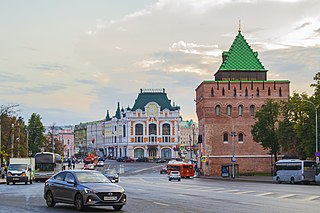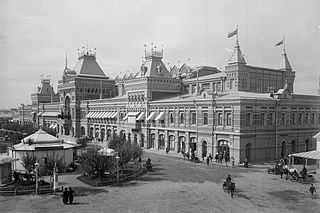
Nizhny Novgorod is the administrative centre of Nizhny Novgorod Oblast and the Volga Federal District in Russia. The city is located at the confluence of the Oka and the Volga rivers in Central Russia, with a population of over 1.2 million residents, up to roughly 1.7 million residents in the urban agglomeration. Nizhny Novgorod is the sixth-largest city in Russia, the second-most populous city on the Volga, as well as the Volga Federal District. It is an important economic, transportation, scientific, educational and cultural centre in Russia and the vast Volga-Vyatka economic region, and is the main centre of river tourism in Russia. In the historic part of the city there are many universities, theatres, museums and churches.

Nizhny Novgorod Oblast is a federal subject of Russia. Its administrative center is the city of Nizhny Novgorod. It has a population of 3,119,115 as of the 2021 Census. From 1932 to 1990 it was known as Gorky Oblast.

Nizhny Novgorod Fair was a fair in Nizhny Novgorod held annually every July near Makaryev Monastery on the left bank of the Volga River from the mid-16th century to 1816. Following a massive fire in 1816, it was moved to Nizhny Novgorod, but for some decades thereafter it still was commonly referred to as Makaryev Fair. It attracted foreign merchants from India, Iran, and Central Asia.

The All-Russia industrial and art exhibition 1896 in Nizhny Novgorod was held from May 28 till October 1, 1896. The 1896 exhibition was the largest pre-revolution exhibition in the Russian Empire and was organized with money allotted by Nicholas II, Emperor of Russia. The All-Russia industrial conference was held together with the exhibition.

The Nizhny Novgorod Kremlin is a fortress (kremlin) in the historic city center of Nizhny Novgorod, Russia.
The following is a timeline of the history of the city of Riga, Latvia.
The following is a timeline of the history of the city of Moscow, Russia.
The following is a timeline of the history of the city of Kharkiv, Ukraine.
The following is a timeline of the history of the city of Rostov-on-Don, Russia.
The following is a timeline of the history of the city of Yekaterinburg, Russia.
The following is a timeline of the history of the city of Kazan, Tatarstan, Russia.
The following is a timeline of the history of the city of Volgograd, Russia.
The following is a timeline of the history of the city of Krasnodar, Russia.
The following is a timeline of the history of the city of Omsk, Russia.
The following is a timeline of the history of the city of Pskov, Russia.
The following is a timeline of the history of the city of Samara, Russia.

Nizhny Novgorod was founded by Prince Yuri II of Vladimir in 4 February 1221. Citizens organized an army to liberate Moscow from the Poles in 1611, led by Kuzma Minin and Prince Dmitry Pozharsky. During the Russian Empire, in 1817 Nizhny Novgorod became the country's main trading city. In 1896, the city hosted the largest All-Russia exhibition. In the Soviet era, Nizhny Novgorod was renamed Gorky, in honor of the writer Maxim Gorky. Then it was the industrial center of the Soviet Union. During the World War II, the city sent to the front a huge amount of military equipment and ammunition. Therefore, the German air force bombed the city for 3 years. After the dissolution of the Soviet Union, the city was renamed back to Nizhny Novgorod. In Russia, the city became a political center and the capital of the Volga Federal District. Now the city is the center of information technology and develops tourism.

The Spit of Nizhny Novgorod is one of the main natural landmarks in the historical centre of Nizhny Novgorod. It is located at the confluence of the Oka and Volga rivers.
Poltava is a city on the Vorskla River in central Ukraine, in existence since the Middle Ages.







